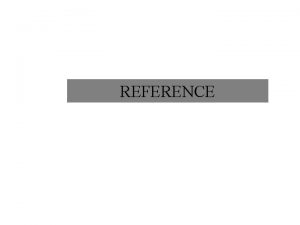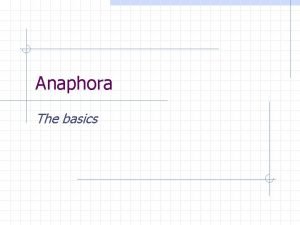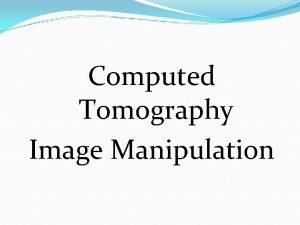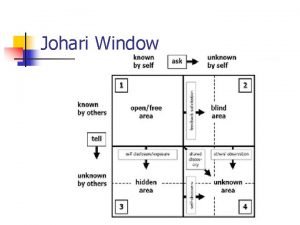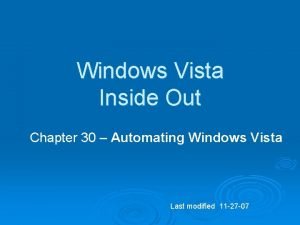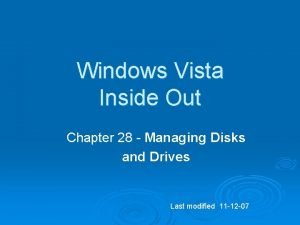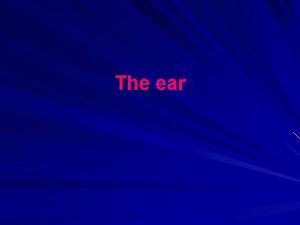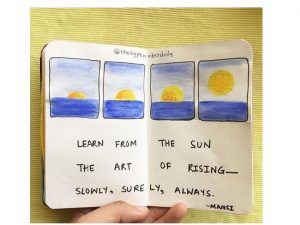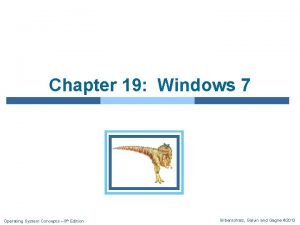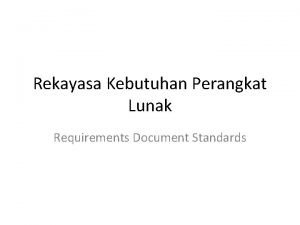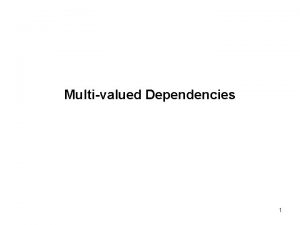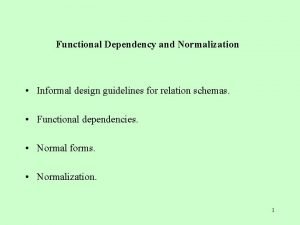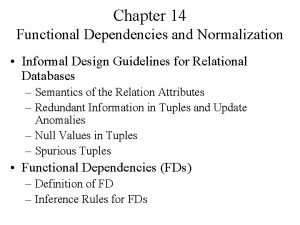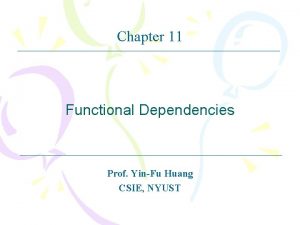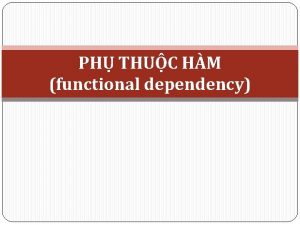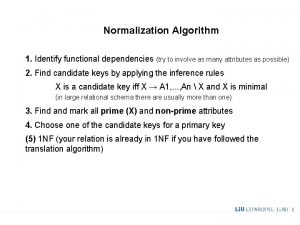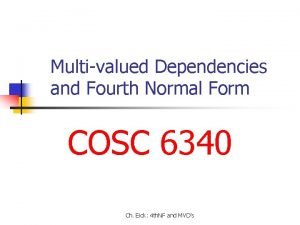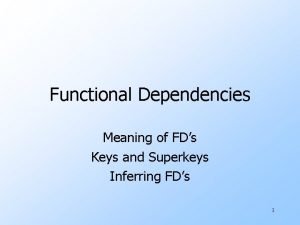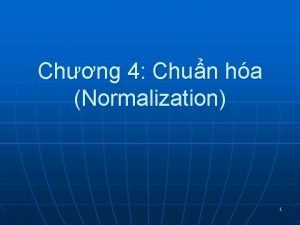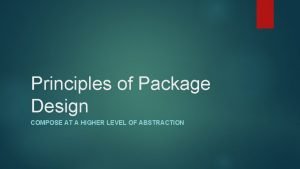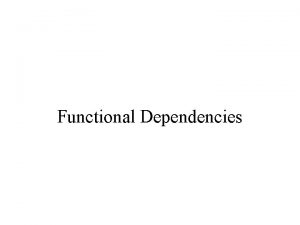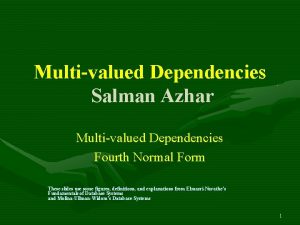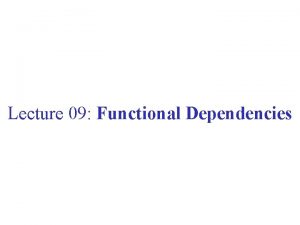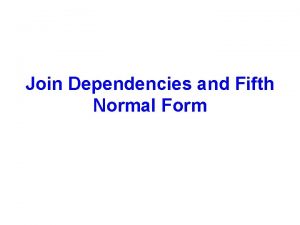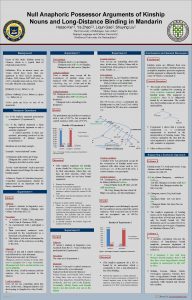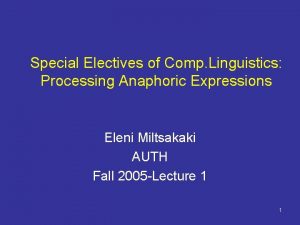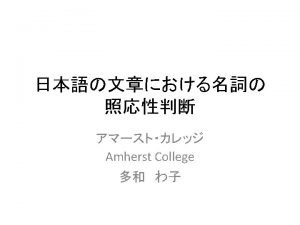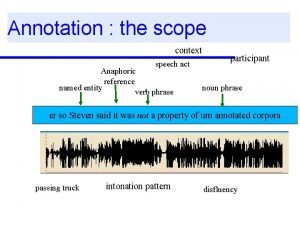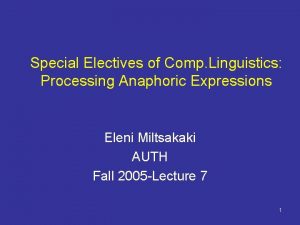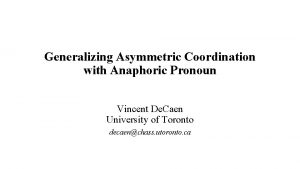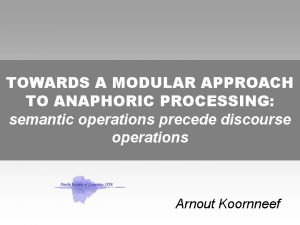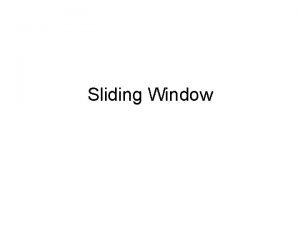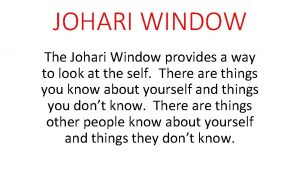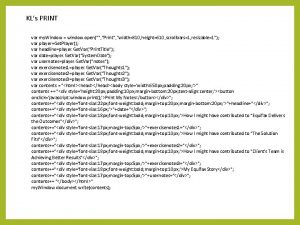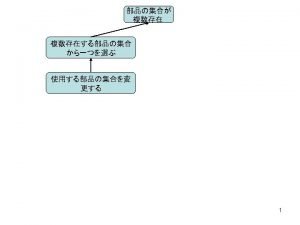Anaphoric dependencies A window into the architecture of



















































- Slides: 51

Anaphoric dependencies: A window into the architecture of the language system Eye tracking experiments Eric Reuland Frank Wijnen Arnout Koornneef

EYE-TRACKING BY ARNOUT KOORNNEEF

OVERVIEW OF LECTURE • Part 1: discussion of method - eye-tracking while reading • Part 2: discussion of current research - eye-tracking experiments

THE EYE-TRACKER

THE EYE-TRACKER

THE EYE-TRACKER • monitors eye-movements from millisecond to millisecond • provides information about where people look and for how long

TWO MAIN EYETRACKING PARADIGMS • eye-tracking while reading • eye-tracking while listening (not discussed)

EYE-TRACKING WHILE READING

SOME FACTS ABOUT READING • people do not read a text “smoothly”, but fixate a particular word (200 - 300 msec) and jump to the next • a jump (or saccade) covers 7 -9 letter spaces • during a saccade visual input is reduced • readers skip short words and words that are highly predictable (these words are identified in the parafoveal region) • readers regress (look back) • readers often undershoot on return sweeps (going from the end of a line to the next line) • the perceptual span is asymmetrical to the right (to the left for languages like Hebrew)

SOME FACTS ABOUT READING • people do not read a text “smoothly”, but fixate a particular word (200 - 300 msec) and jump to the next • a jump (or saccade) covers 7 -9 letter spaces • during a saccade visual input is reduced • readers skip short words and words that are highly predictable (these words are identified in the parafoveal region) • readers regress (look back) • readers often undershoot on return sweeps (going from the end of a line to the next line) • the perceptual span is asymmetrical to the right (to the left for languages like Hebrew)

SOME FACTS ABOUT READING • people do not read a text “smoothly”, but fixate a particular word (200 - 300 msec) and jump to the next • a jump (or saccade) covers 7 -9 letter spaces • during a saccade visual input is reduced • readers skip short words and words that are highly predictable (these words are identified in the parafoveal region) • readers regress (look back) • readers often undershoot on return sweeps (going from the end of a line to the next line) • the perceptual span is asymmetrical to the right (to the left for languages like Hebrew)

SOME FACTS ABOUT READING • people do not read a text “smoothly”, but fixate a particular word (200 - 300 msec) and jump to the next • a jump (or saccade) covers 7 -9 letter spaces • during a saccade visual input is reduced • readers skip short words and words that are highly predictable (these words are identified in the parafoveal region) • readers regress (look back) • readers often undershoot on return sweeps (going from the end of a line to the next line) • the perceptual span is asymmetrical to the right (to the left for languages like Hebrew)

SOME FACTS ABOUT READING • people do not read a text “smoothly”, but fixate a particular word (200 - 300 msec) and jump to the next • a jump (or saccade) covers 7 -9 letter spaces • during a saccade visual input is reduced • readers skip short words and words that are highly predictable (these words are identified in the parafoveal region) • readers regress (look back) • readers often undershoot on return sweeps (going from the end of a line to the next line) • the perceptual span is asymmetrical to the right (to the left for languages like Hebrew)

SOME FACTS ABOUT READING • people do not read a text “smoothly”, but fixate a particular word (200 - 300 msec) and jump to the next • a jump (or saccade) covers 7 -9 letter spaces • during a saccade visual input is reduced • readers skip short words and words that are highly predictable (these words are identified in the parafoveal region) • readers regress (look back) • readers often undershoot on return sweeps (going from the end of a line to the next line) • the perceptual span is asymmetrical to the right (to the left for languages like Hebrew)

SOME FACTS ABOUT READING • people do not read a text “smoothly”, but fixate a particular word (200 - 300 msec) and jump to the next • a jump (or saccade) covers 7 -9 letter spaces • during a saccade visual input is reduced • readers skip short words and words that are highly predictable (these words are identified in the parafoveal region) • readers regress (look back) • readers often undershoot on return sweeps (going from the end of a line to the next line) • the perceptual span is asymmetrical to the right (to the left for languages like Hebrew)

SOME FACTS ABOUT READING • people do not read a text “smoothly”, but fixate a particular word (200 - 300 msec) and jump to the next • a jump (or saccade) covers 7 -9 letter spaces • during a saccade visual input is reduced • readers skip short words and words that are highly predictable (these words are identified in the parafoveal region) • readers regress (look back) • readers often undershoot on return sweeps (going from the end of a line to the next line) • the perceptual span is asymmetrical to the right (to the left for languages like Hebrew)

A TYPICAL READING EXPERIMENT Garden-path sentence Since Jay always jogs a mile seems like a short distance to him. Control sentence Since Jay always jogs a mile this seems like a short distance to him.

READING PATTERN (Garden-path sentence) Since Jay always jogs a mile seems like a short distance to him.

READING PATTERN (Garden-path sentence) Since Jay always jogs a mile seems like a short distance to him. = fixation after progressive saccade (first-pass) = fixation after regressive saccade = fixation after progressive saccade (second-pass)

READING PATTERN • If readers experience some sort of trouble they may fixate the difficult region longer and the may even regress to earlier parts of the sentence/text.

HOW DO WE INTERPRET THE READING PATTERNS?

DIFFERENT MEASURES • First fixation duration: duration of first fixation in a region • First-pass duration: time spent in a region before moving on or looking back • Regression path duration: time from first entering a region until moving the eyes beyond that region, includes regression time • Second-pass duration: duration of re-fixations • Total duration: the sum of all fixations in a region • Probability of a regression: the percentage of regressive eye-movements out of a region

DIFFERENT MEASURES • First fixation duration: duration of first fixation in a region • First-pass duration: time spent in a region before moving on or looking back • Regression path duration: time from first entering a region until moving the eyes beyond that region, includes regression time • Second-pass duration: duration of re-fixations • Total duration: the sum of all fixations in a region • Probability of a regression: the percentage of regressive eye-movements out of a region

DIFFERENT MEASURES • First fixation duration: duration of first fixation in a region • First-pass duration: time spent in a region before moving on or looking back • Regression path duration: time from first entering a region until moving the eyes beyond that region, includes regression time • Second-pass duration: duration of re-fixations • Total duration: the sum of all fixations in a region • Probability of a regression: the percentage of regressive eye-movements out of a region

DIFFERENT MEASURES • First fixation duration: duration of first fixation in a region • First-pass duration: time spent in a region before moving on or looking back • Regression path duration: time from first entering a region until moving the eyes beyond that region, includes regression time • Second-pass duration: duration of re-fixations • Total duration: the sum of all fixations in a region • Probability of a regression: the percentage of regressive eye-movements out of a region

DIFFERENT MEASURES • First fixation duration: duration of first fixation in a region • First-pass duration: time spent in a region before moving on or looking back • Regression path duration: time from first entering a region until moving the eyes beyond that region, includes regression time • Second-pass duration: duration of re-fixations • Total duration: the sum of all fixations in a region • Probability of a regression: the percentage of regressive eye-movements out of a region

DIFFERENT MEASURES • First fixation duration: duration of first fixation in a region • First-pass duration: time spent in a region before moving on or looking back • Regression path duration: time from first entering a region until moving the eyes beyond that region, includes regression time • Second-pass duration: duration of re-fixations • Total duration: the sum of all fixations in a region • Probability of a regression: the percentage of regressive eye-movements out of a region

DIFFERENT MEASURES • First fixation duration: duration of first fixation in a region • First-pass duration: time spent in a region before moving on or looking back • Regression path duration: time from first entering a region until moving the eyes beyond that region, includes regression time • Second-pass duration: duration of re-fixations • Total duration: the sum of all fixations in a region • Probability of a regression: the percentage of regressive eye-movements out of a region

EXPLANATION OF DIFFERENT MEASURES Bart annoyed Homer because… 1 2 5 3 4 6 Reading Times for word 3 (Homer) First fixation duration = 3 First-pass duration = 3 + 4 Regression Path duration = 3 + 4 + 5 Second-pass duration = 6 Total duration = 3 + 4 + 6 7

DIFFERENT FIRST-PASS MEASURES FIRST FIXATION DURATION FIRST-PASS DURATION REGRESSION PATH DURATION TIME

HOW DO WE INTERPRET THE READING TIMES?

THE LINKING PROBLEM eye mind

EYE-MIND ASSUMPTION (JUST & CARPENTER, 1980) • Readers retain fixation on a word until processing is completed • This includes processes like word recognition, syntactic parsing, semantic integration, referential integration

AN IDEAL WORLD (VAN BERKUM, 2004) Snowwhite W P S kissed a dwarf R W P S R TIME W = word recognition; P = parsing; S = semantic integration; R = referential integration

THE REAL WORLD IS A REAL MESS (VAN BERKUM, 2004) Snowwhite W P S kissed a dwarf R W P W S P R S W R P S R TIME W = word recognition; P = parsing; S = semantic integration; R = referential integration

THE REAL WORLD IS A REAL MESS • In the real world the processing of word X continues while fixating word X + 1 (and possibly while fixating word X + 2 etc. ) • Thus, the effects of a manipulation are often visible more downstream (i. e. after the critical word or region). This is called spill-over.

THE REAL WORLD IS A REAL MESS • In the real world the processing of word X continues while fixating word X + 1 (and possibly while fixating word X + 2 etc. ) • Thus, the effects of a manipulation are often visible more downstream (i. e. after the critical word or region). This is called spill-over.

LINKING ASSUMPTION (BOLAND, 2004) • The eyes do not leave a word until it has been structurally integrated (tree building). Therefore, constraints that control structure-building influence first-pass reading time. other measures (e. g. , regression path duration) are sensitive for higher level processes (semantic integration, discourse processes)

SOLUTION LINKING PROBLEM? • Perhaps the different measures can provide information about what is happening? (this is an empirical question)

A DISADVANTAGE OF THE READING PARADIGM • You can only use skilled readers (no children or language-disordered populations). • This is possible in spoken language paradigms.

CAVEAT: • the eyes tell us that something is happening at a specific point in time, but not what that something is!

TO CONCLUDE • Eye-tracking (while reading and listening) excels in the “when” question. • Not really suited for “what” question (use EEG/MEG instead).

QUESTIONS?

PART 2: THEORY

CONSTRUCTING ANAPHORIC DEPENDENCIES: VARIABLE BINDING vs. CO-REFERENCE

BASIC ARCHITECTURE PROCESSING SYSTEM • distinct modules syntax, semantics, discourse • economy principle: cross-modular operations carry a cost (Reuland 2001) • syntax first in time-course-model of processing phases (Friederici 1995 -) syntax is cheaper than semantics is cheaper than discourse

CROSS-MODULAR OPERATIONS Discourse storage (values) C-I objects (variables) Syntactic objects (chains) Basic expressions a x 1 C 1 α Discourse storage (values) C-I objects (variables) Syntactic objects (chains) a x 1 C 1 Basic expressions α a x 2 C 2 β x 1 C 2 β C 1 β

TIME-COURSE SIMPLIFIED SYNTAX SEMANTICS DISCOURSE

SEMANTICS VS. DISCOURSE • variable binding (semantic dependency) Every clown thinks that he is not funny. • co-reference (discourse dependency) The clown has a big problem. He is not funny.

PREDICTIONS OF THEORY • variable binding is cheaper/faster than co-reference • in an ambiguous situation variable binding has precedence over co-reference

END OF INTRO
 Cataphoric synonym
Cataphoric synonym Anaphoric marketing
Anaphoric marketing Anaphoric
Anaphoric Anaphoric
Anaphoric Proseso sa paggamit ng note card
Proseso sa paggamit ng note card Window width ct
Window width ct Johari window personality test
Johari window personality test Windows 7 inside out
Windows 7 inside out Windows vista disk management
Windows vista disk management Chorda tympani
Chorda tympani Impedance matching ear
Impedance matching ear Window to window chapter 19
Window to window chapter 19 Assumptions and dependencies example
Assumptions and dependencies example Assumptions and dependencies example
Assumptions and dependencies example Multi valued dependencies
Multi valued dependencies Informal guidelines for relational schema
Informal guidelines for relational schema Dependencies adrenalin ui
Dependencies adrenalin ui Informal design definition
Informal design definition Irreducible set of functional dependencies
Irreducible set of functional dependencies Functional dependencies and normalization
Functional dependencies and normalization Identify functional dependencies
Identify functional dependencies Multi-valued dependency
Multi-valued dependency Fd's meaning
Fd's meaning Functional dependencies and normalization
Functional dependencies and normalization Stable abstractions principle
Stable abstractions principle Hát kết hợp bộ gõ cơ thể
Hát kết hợp bộ gõ cơ thể Slidetodoc
Slidetodoc Bổ thể
Bổ thể Tỉ lệ cơ thể trẻ em
Tỉ lệ cơ thể trẻ em Voi kéo gỗ như thế nào
Voi kéo gỗ như thế nào Chụp phim tư thế worms-breton
Chụp phim tư thế worms-breton Hát lên người ơi
Hát lên người ơi Các môn thể thao bắt đầu bằng tiếng nhảy
Các môn thể thao bắt đầu bằng tiếng nhảy Thế nào là hệ số cao nhất
Thế nào là hệ số cao nhất Các châu lục và đại dương trên thế giới
Các châu lục và đại dương trên thế giới Cong thức tính động năng
Cong thức tính động năng Trời xanh đây là của chúng ta thể thơ
Trời xanh đây là của chúng ta thể thơ Mật thư tọa độ 5x5
Mật thư tọa độ 5x5 101012 bằng
101012 bằng Phản ứng thế ankan
Phản ứng thế ankan Các châu lục và đại dương trên thế giới
Các châu lục và đại dương trên thế giới Thể thơ truyền thống
Thể thơ truyền thống Quá trình desamine hóa có thể tạo ra
Quá trình desamine hóa có thể tạo ra Một số thể thơ truyền thống
Một số thể thơ truyền thống Cái miệng bé xinh thế chỉ nói điều hay thôi
Cái miệng bé xinh thế chỉ nói điều hay thôi Vẽ hình chiếu vuông góc của vật thể sau
Vẽ hình chiếu vuông góc của vật thể sau Thế nào là sự mỏi cơ
Thế nào là sự mỏi cơ đặc điểm cơ thể của người tối cổ
đặc điểm cơ thể của người tối cổ Thế nào là giọng cùng tên
Thế nào là giọng cùng tên Vẽ hình chiếu đứng bằng cạnh của vật thể
Vẽ hình chiếu đứng bằng cạnh của vật thể Fecboak
Fecboak Thẻ vin
Thẻ vin
